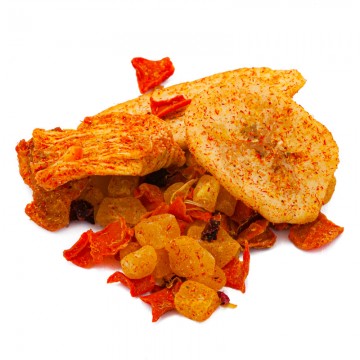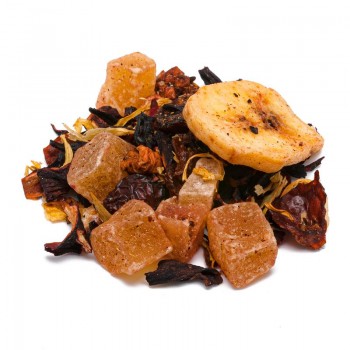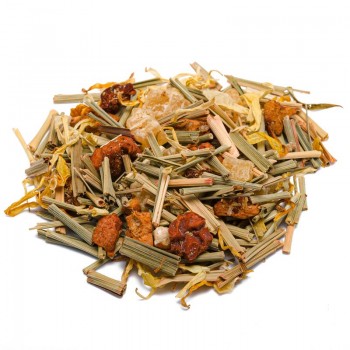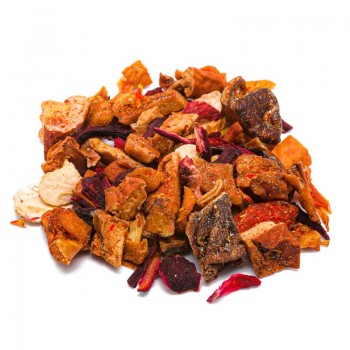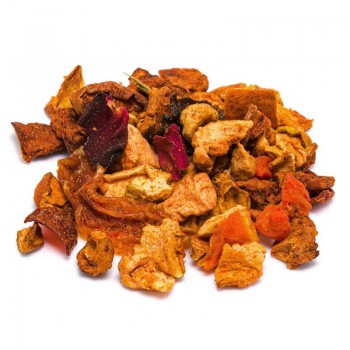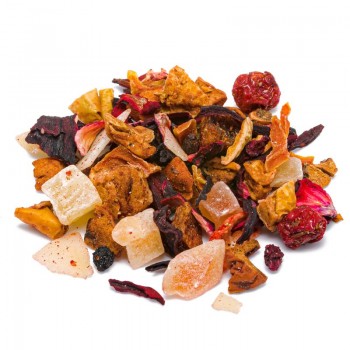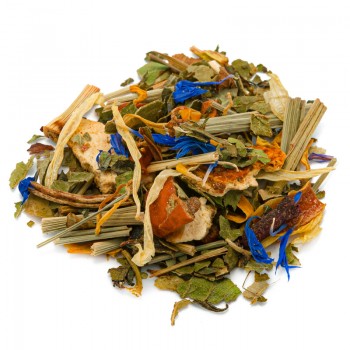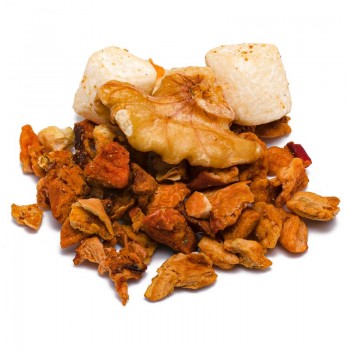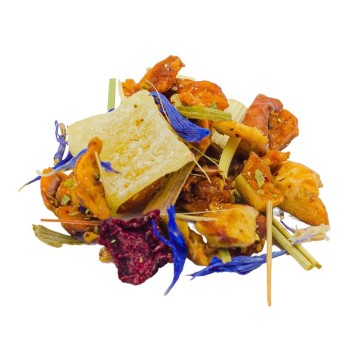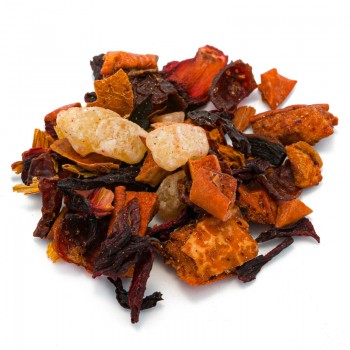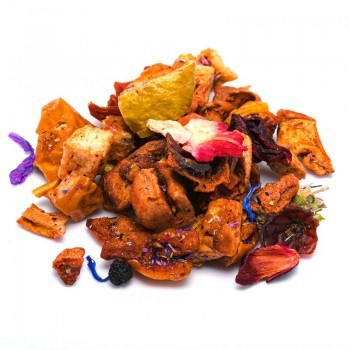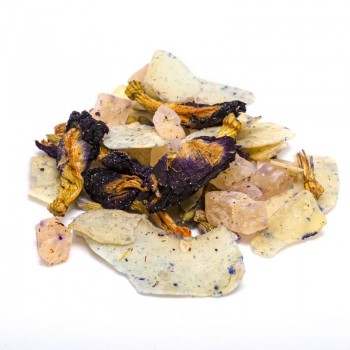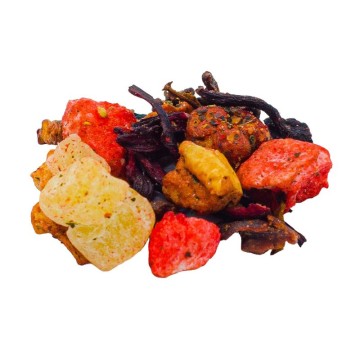The infusion with a fresh and summery taste, shows sweet and balanced notes between hibiscus, wild berries and flowers. It becomes intriguing on the palate after having enveloped us in an original perfume. It is a captivating drink that comes from a perfect combination of different elements, which include exotic fruit, red fruits, aromatic flowers. A sensory journey to tropical places, mixing papaya and hibiscus with strawberries and currants. The infusion is enriched with delicate flowers, with flavors to which there is no need to add sugar. It can be enjoyed both hot and cold. Perfect as an invigorating and warming in winter, when it also evokes spring fruits, such as apple, strawberry and raspberry. Gives a refreshing effect in the hottest season, invigorating thanks to the vitamins. Some use this blend for its berry undertones, to make cocktails or exquisite drinks (such as alcohol-free mocktail mixes).
Strawberry and mango infusion: properties and benefits
The drink is a beneficial source of vitamins and antioxidants. The ingredients of the infusion are particularly rich in vitamin C and have a fair amount of vitamin A. Hibiscus, for example, contains a potent dose of polyphenols that help fight the damage that free radicals do to our cells. Together with the other vitamins, the antioxidant polyphenols and other nutrients present in strawberries and elderberries can help strengthen the immune system and give us well-being. Some natural elements present give our body diuretic properties, enhanced by the liquid form of the infusion. Elderberries are combined with strawberries and ensure an action that eliminates excess liquids, facilitating diuresis and counteracting water retention. It is also associated with purifying hibiscus for the urinary tract and with a diuretic effect. Due to its characteristics, this infusion also has elements useful for counteracting the effects of hay fever (allergic rhinitis) and improving our "breath" through the supply of vitamin C, which also helps to reduce symptoms of respiratory system irritations. Another positive effect is due to the relaxation of the respiratory system. It also relaxes the muscles in the digestive tract, so it can be useful as an infusion to soothe gastro-intestinal disorders and tensions due to menstrual syndrome. You can drink this infusion to balance stomach acids, calm heartburn, swelling or reflux situations - best after meals. It has a balancing effect that helps counteract diarrhea and constipation. Its delicate and pleasant flavor makes it much appreciated by adults and children. In particular, it is recommended as a natural drink for those who do sports and need to replenish liquids and vitamins.
Origins and History of cultivation
The blend features several ingredients, which help the well-being of the urinary and digestive systems. In particular, we treat the strawberry protagonist of the infusion. A plant known since ancient times, wild strawberries (Fragaria vesca) were a source of delicious fruits, consumed by populations all over the world. In small quantities, however, because the fruits were small and hard - in some cases they had little flavor. In any case, the strawberry was also used as a remedy. Native Americans used strawberries as a natural medicine, especially to eliminate toxins and promote fertility in women. In Asia, the detoxifying properties of the strawberry were already known around 2600 BC, when the Chinese emperor used tea with leaves of the strawberry plant to detoxify and reduce the effects of aging. The Roman poets Virgil and Ovid mentioned the strawberry in the 1st century AD, known above all as an ornamental. The fruit was symbolic of love, representing a heart, but was used to relieve bad breath and treat digestive disorders. The strawberry's popular reputation for fertility is noted in many myths, where it appears as the fruit of deities such as Venus, Aphrodite, the Norse Freya and even the Virgin Mary. Legend has it that sharing the strawberry regulates love between two people. In the Middle Ages the diffusion of strawberries was wide, and in the 14th century the French began to transplant wild strawberries in gardens. At the end of the 16th century, the cultivation of the musk strawberry (Fragaria moschata) also joined in gardens throughout Europe. It was in the seventeenth century that the American strawberry from Virginia (Fragaria virginiana) was imported, which reached Europe and began its diffusion. A hardy new species, but little appreciated until the early 1800s, when it became very popular in England. English gardeners undertook to grow nuwhere seed varieties, passing from three to almost thirty cultivars. Meanwhile, in 1714 the Chilean strawberry (Fragaria chiloensis) arrived in France, a species with a quality that the others lacked: its large size. It yielded larger fruits, provided it was grown on the coast, with a mild climate. These two species of American strawberries were crossed by the French, giving rise to the modern strawberry, Fragaria x ananassa. Natural hybrids were created, with a selection work developed by the British which has led today to the modern varieties of strawberries. The hybridization and selection of plants over time has led to many varieties of strawberries
Fruit and flowers
Various flowers and fruits have been used to create this infusion.
Hibiscus is a flower that derives from the tropical plant Hibiscus sabdariffa, a perennial species of the Malvaceae family. It is native to Africa but widespread in many tropical and subtropical regions of the world (Thailand, China and Mexico). There is also the tropical hibiscus variety. Its large flowers are edible, known for their bright colors and scent.
The apple comes from the Malus domestica plant, a tree of the rose family (Rosaceae). It is one of the most cultivated trees in the world, native to Asia. Apples differ in colors and in many varieties, and have been used in human nutrition for thousands of years.
Elderberry is the berry of the European or black elderberry tree Sambucus nigra. It grows in Europe, North America, Asia and Northern Africa. The elderberry we use is a dark purple berry known in folk medicine to treat colds and flu, as well as being edible.
The papaya fruit comes from the Carica papaya plant, part of the Caricaceae family. It is probably native to Mexico and Central America, and only known in Europe in recent centuries for its succulent fruit.
The strawberry derives from the plant of the genus Fragaria, which includes over 20 species of flowering plants of the rose family (Rosaceae). There are many varieties grown all over the world, among which the most widespread is Fragaria ×ananassa - large-fruited strawberry. The strawberry is not a real berry but a pseudocarp.
Raspberry is the fruit of the bramble plant of the Rubus genus, belonging to the Rosaceae family. Raspberries derive in most cases from cultivars or hybrids of Rubus idaeus and Rubus strigosus. It is a widespread plant in northern Europe, the United States and Canada.
The sunflower is a plant, Helianthus annuus, belonging to the Asteraceae. Originally from North America, it takes its name from its heliotropism: the flower moves following the movements of the sun. It spread to Europe imported by European explorers, and today it is cultivated all over the world.
The cornflower is the flower of the annual plant Centaurea cyanus, of the Asteraceae family. It is a plant native to Europe, which often grew in cereal fields.
Nutritional values of strawberry and mango infusion
The main active ingredients of the infusion are antioxidants such as vitamins C, E, and anthocyanin. It also provides elements such as papain, useful for digestion, and the antioxidants polyphenols and anthocyanins. How to use the ingredients in the infusion
The infusion is obtained by placing about 3-5 grams of the strawberry and mango mixture in a cup (250 ml) with water at 100 °C. Leave to infuse for 10 to 12 minutes before drinking. Add honey or sugar, if desired.
Strawberry and mango infusion: side effects and contraindications
To avoid side effects, it is necessary to respect the recommended doses per cup, and not to exceed the consumption of the infusion for too long periods. Excessive intake can cause diarrhea or constipation, stomach pain, intestinal gas and gastrointestinal disorders. Furthermore, it is advisable to pay attention to all the ingredients of the infusion, for those suffering from food allergies. The strawberry could trigger reactions with urticaria and epidermal burning in sensitive subjects. Caution is advised in pregnant or breastfeeding women.

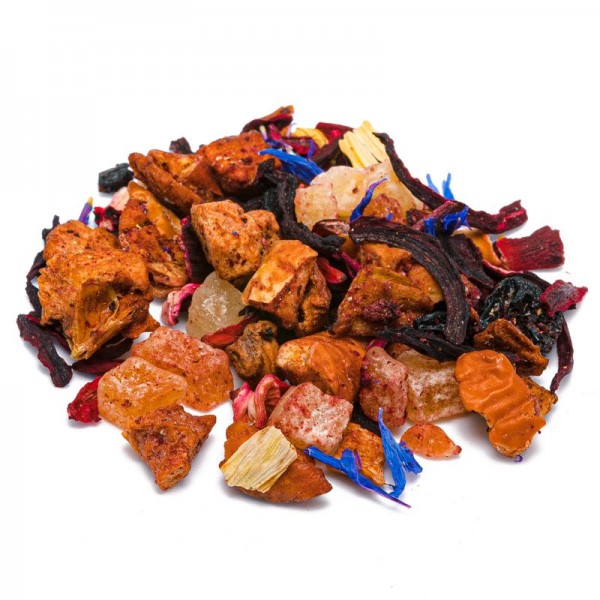









 No reward points for this product.
No reward points for this product.

